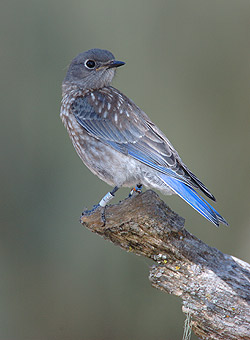Berkeleyan
Always thus: Accumulated wealth encourages family stability
But conversion of Western bluebirds' oak-woodland habitat, frequently for viticulture, as well as losses due to sudden oak death and other natural causes, bode ill for continued biodiversity in central California
![]()
| 26 October 2005
 A Western bluebird fledgling, color-banded at Berkeley's Hastings Reserve in Carmel Valley. If this bird's a female, it will leave home for life on its own sooner than its brothers - for reasons suggested by new Berkeley research. (Copyright 2004 by Neil Losin) |
While female fledglings fly off on their own in late summer, their brothers typically hang around through the winter and into the next breeding season, living off the bounty of their parents' larder. As with humans, though, as the money runs low, the kids split, according to a new study by Berkeley scientists.
Janis Dickinson, a research associate with the Museum of Vertebrate Zoology and a newly appointed associate professor of natural resources at Cornell University, discovered parallels between human and bird families while studying the evolution of delayed dispersal, or natal philopatry - the tendency of offspring to stay at or near home rather than look for a new place to live and breed. Such behavior is common among cooperatively breeding birds as well as humans - and, at least in birds, it leads to close-knit families.
"The idea that inherited wealth promotes family stability comes from studies of cooperatively breeding birds and helps expand our theoretical understanding of the evolution of human social behavior," says Dickinson, who also directs the Citizen Science program at the Cornell Laboratory of Ornithology. "What has been lacking is an experimental demonstration that resource wealth promotes delayed dispersal, leading to the continuation of relationships between offspring and parents prerequisite for cooperative family life."
For bluebirds, "wealth" consists of mistletoe berries, an abundant winter food source growing on California oaks. Since the bluebirds also could be staying at home because they're babied by their parents - they're treated far better there than they would be outside their parents' territory - Dickinson manipulated this food source to see what the filial hangers-on would do.
"Wealth of resources is not the only feature of remaining with parents that could cause offspring to stay at home," Dickinson says. "The Western bluebird fledglings stay on their parents' territory living in cohesive groups where they sleep together in a cavity or nest box or in the mistletoe, forage together, and the mothers are nicer to their sons than they are to other males of the same age, even if those birds are members of their winter group. Since mothers show nepotism towards their offspring, this could also play a role in why sons stay. What our experiment shows is that reducing resource wealth causes sons to leave their parents, even if it means giving up nepotistic benefits."
Dickinson found that while half of all male offspring normally stick around during the winter, only 8 percent stayed when she removed half the mistletoe from trees in the parent bluebirds' territory.
"Animals, including humans, can accumulate resources by staying in one place, or they can stay in one place because of the benefits of access to accrued resources," she says. "This is a first demonstration that experimentally manipulating the resource itself reduces the phenomenon of delayed dispersal, which means that the wealth - the amount of resources the parents have - causes delayed dispersal."
An uncle up the hill
Dickinson conducted her studies at Berkeley's Hastings Natural Reserve and nearby ranches in Carmel Valley, where for more than 20 years researchers have been banding Western bluebirds (Sialia mexicana) and tracking their family relationships. The bluebirds, which live a maximum of eight years but typically only three to four, tend to hold onto their territories throughout their lifetime. A typical territory might contain five birds overwintering together, including parents, sons, and immigrant females. Apparently because of delayed dispersal, when the sons leave in the spring, they tend to nest nearby, creating an extended family.
"There are families of a father and mother with three sons nesting nearby, a daughter a kilometer away, and an uncle up the hill, so it's common for family members to live quite close together," she says.
Starting in 2001, Dickinson and undergraduate interns began cataloguing the mistletoe resources available in each mating pair's territory, and during the spring of 2003 she and her colleague Andrew McGowan, a former museum researcher, removed mistletoe from 13 territories - a Herculean task requiring weeks of tree-climbing and trimming.
In contrast to the situation on 13 undisturbed territories, Dickinson noticed that sons in the depleted territories, rather than sticking around through the winter, left at the same time as their sisters in late summer. And they seemed to leave of their own volition, rather than being kicked out by their parents.
Dickinson noted that development along California's Central Coast, from Santa Barbara County to Monterey County in particular, is leading to clearcutting of the oaks that support mistletoe and provide winter food for the Western bluebird. Combined with the declining regeneration of blue and valley oaks and the loss of coast live oaks and tanoaks to sudden oak death, food resources for birds are taking a big hit.
"This close association with mistletoe implies that the decline of Western bluebirds in California might be greatly exacerbated by conversion of the oak woodlands to agriculture, particularly for vineyard development," she says. "I think they should put vineyards in previously cleared fields, without cutting old-growth oaks.
"The bluebirds are a signature species, but this is probably affecting other species as well. Our work suggests that the biodiversity of central coastal California will be determined largely by how we treat the old-growth oak forests of California in the next decade."

